1.4. Recognizing Media Connectors
No matter what type of cable you are using, it won't be very effective unless it has the proper connectors on each end. The type of connectors that you use will depend on the cable as well as on your intended use for the cable. In other words, you need to have the proper connectors to plug into the devices that you are trying to use. In this section, we discuss the most common types of media connectors used in networks.
1.4.1. Critical Information
You should be able to recognize by sight the most common types of cable connectors and describe their main use. In this section, we will discuss the purpose of the major types of connectors and provide a photograph of each type.
1.4.1.1. RJ-11
"RJ" stands for registered jack. Chances are good that you have held an RJ-11 connector in your hand, since they are used on all of the telephone connections in the United States and most other countries. An RJ-11 connector can contain and connect two pairs of wires. In regard to computers, you are most likely to use an RJ-11 connector when you attach a modem to a telephone line. In fact, you plug an RJ-11 into the wall and another one into the modem. Figure 1.7 shows an RJ-11 connector on the left.
1.4.1.2. RJ-45
The RJ-45 connector is the most common network connector. It is used to connect network interface cards (NICs) to hubs and/or switches. RJ-45s can also be used to connect network devices together for communication as well as control. The RJ-45 connector can contain and connect four pairs of wires. For example, RJ-45 connectors are used to connect computer cables to a patch panel, a patch panel to a switch, and then to connect the switch to a router in order to supply a user connection to the Internet. Figure 1.7 shows an RJ-45 connector on the right.
Figure 1.7. An RJ-11 connector (left) and an RJ-45 connector (right)

1.4.1.3. F-Type
Although coaxial cables are rarely used for computer network backbones, they have experienced a resurgence of growth because they are used to connect a cable modem to an NIC to provide a computer with a broadband Internet connection. Many of the newest coaxial cables use a new connector that slides onto the coaxial cable connection on a device with just one quick push. This new connector is referred to as an F-type connector. F-type connectors make connecting cable modems to the cable company's connections much easier than with previous connectors that had to be twisted many times to secure the connection. Figure 1.8 shows an F-type connector.
Figure 1.8. An F-type connector

1.4.1.4. ST
The ST (straight tip) connector is a type of fiber-optic cable connector. It uses a half-twist bayonet type of lock to hold it in place securely. ST connectors are most commonly used with single-mode fiberoptic cable that runs long distances. For example, an ST connector might be used on either side of a fiber backbone between two buildings on a corporate campus. Figure 1.9 shows an ST connector.
Figure 1.9. An ST connector

1.4.1.5. SC
The SC (standard connector) connector is a type of fiberoptic cable connector. It uses a pushpull connector mechanism that is similar to common audio and video plugs. SC connectors are most often used with multimode fiberoptic cable that is providing a backbone segment for a LAN. For example, SC connectors might be used on either side of a fiber backbone that runs between the floors of a single building. (We will discuss single-mode and multimode fiberoptic cable later in this chapter.) Figure 1.10 shows an SC connector.
Figure 1.10. An SC connector

1.4.1.6. IEEE 1394
Specially developed for transferring pictures and video, the IEEE 1394 standard (also known as FireWire) has its own type of connector. You can recognize an IEEE 1394 connector by its small and distinctive "D" shape. This type of connector is now found on many types of video and multimedia devices. For example, you might use an IEEE 1394 connector to connect a digital video recorder to a computer to download pictures. Figure 1.11 shows an IEEE 1394 connector cable.
Figure 1.11. An IEEE 1394 connector cable

1.4.1.7. LC
The LC (local connector) connector is a fiber connector that is built into the body of an RJ-style jack. The LC connector is used for local connections. This type of connector is generally found on a fiberoptic patch cord that is used to connect fiberoptic equipment within the network closet itself. Figure 1.12 shows an LC connector.
Figure 1.12. An LC connector

1.4.1.8. MTRJ
The MTRJ connector is one of the newest designs for connecting fiberoptic cable. The new connector is easier to use and smaller that the older types of connectors. Due to their rugged and durable design, they are becoming the connector of choice for use in the network and telecom closet of an organization. Figure 1.13 shows an MTRJ connector.
Figure 1.13. An MTRJ connector
1.4.2. Exam Essentials
Be able to recognize the main types of connectors used in networks. Be able to recognize a photo of the most common media connectors that we described in this chapter and discuss its normal use.
Know the characteristics of the RJ-11 connector. RJ stands for registered jack, and the RJ-11 connector is the connector that is commonly used with regular telephone lines. The RJ-11 connector contains four wires to be used as two pairs of wires. RJ-11 connectors are used to connect modems to telephone lines for communication on the Internet.
Describe the characteristics of the RJ-45 connector. The RJ-45 connector is the most common network connector. It is used to connect various types of network equipment, including patch panels, hubs, switches, and routers. The RJ-45 connector contains eight wires, or four pairs of wires.
List the characteristics of the F-type connector. The F-type connector is a new connector developed for use with coaxial cable connections. It provides a faster connection than the older type (BNC) connectors that were used for coaxial cable. The main use for coaxial cable these days is to connect cable modems to the cable company's outlet to create a connection to the Internet.
Know the characteristics of ST connectors. The ST connector is a type of fiberoptic cable connector that uses a half-twist bayonet type of lock. The ST connector is typically used with single-mode fiberoptic cable that runs long distances.
List the characteristics of SC connectors. The SC connector is a type of fiber-optic connector. It is a pushpull connector that is similar to audio and video plugs. The SC connector is most often used to connect a fiberoptic backbone segment within a LAN.
Be familiar with the characteristics of IEEE 1394 connectors. IEEE 1394 is a video and mul-timedia connector that is commonly referred to as FireWire. The IEEE 1394 connector has a distinctive "D" shape. The main purpose of the IEEE 1394 standard is increased speed of data transfer for video and multimedia applications.
Know the characteristics of LC connectors. The LC connector is a type of fiber connector. It is used to connect fiberoptic equipment within the network closet. This type of connector is generally found on patch cords that are used to connect fiberoptic equipment for short distances.
Describe the characteristics of MTRJ connectors. The MTRJ connector is a type of fiber connector. It is typically used to connect fiberoptic equipment for short distances in the network and telecom closet, as is the LC connector. The MTRJ connector is beginning to replace the LC connector because of its rugged design and durability.
